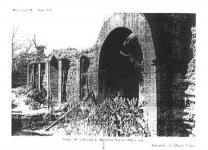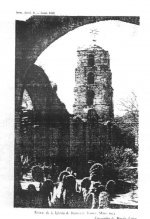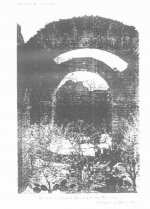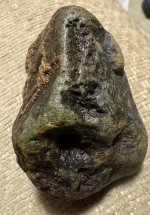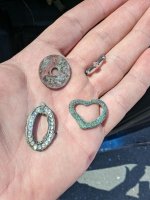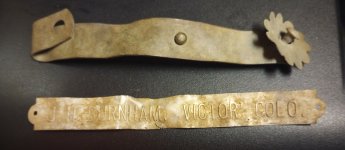Knipper
Jr. Member
- Jan 21, 2005
- 48
- 34
- Detector(s) used
- Minelab Explorer SE, Minelab Excalibur II Troy Shadow X-5
The "12-21" method (long)
I don't know if anyone has ever heard of or used this detecting technique, but it was taught to me by a dealer friend back when VLF/TR detectors had been out a while. It worked unbelievably well in determining good finds including some very deep signals. I'd like to share it with the group.
The "12-21" method is a discriminating technique that is used in the all metal or pinpoint mode only. That's right, you DON'T set your machine to tune out junk, and only use the all metal mode. Back then, the all metal mode was not 'automatically tuned' and once set to a stable, ground balanced even, low threshold of sound you could start using this technique.
Once a signal was located and pinpointed, (switch to all metal or pinpoint mode if you're not already there...) mark the center of the target on the ground with a stick or non metallic object (a small colored plastic dime sized disc works well). Then make sure you have an audible, stable audio tone in all metal or pinpoint mode. You then move the edge of the coil to the right of the target about 6 inches from where it was centered. Re tune the detector while the coil is flat to the ground, so you get an even threshold tone. (Always keep the coil tight to the ground, or 'scrub it'). SLOWLY move the coil toward the target center. When the threshold tone just starts to increase, STOP...and note where the edge of your coil is. That is the first signal, or Number 1. ( When you just start doing this, placing a small stick EXACTLY where the edge of your coil is when the sound started to increase helps.)
Then move the outside edge of the coil six inches or so the the LEFT of target center and move the coil slowly toward center. Again, when the sound JUST STARTS to increase, stop and note where the the edge of the coil is. That is the second signal or Number 2. If the stopping points indicate the edges of the coil overlapped, even slightly....DIG! If the points where the signals started from either direction did NOT overlap, it is junk.
The reason its referred to as the "12-21" method is that the digit '1' represents where the first signal started and the digit '2' is the start of the second signal. Assuming you always start right of center to get the first signal, the pattern would be illustrated by the number 12, which shows that the signals overlapped. If you get the number 21, then the signals didn't overlap.
(Trying to explain this in writing may come across as confusing....the main thing to remember is noting if the edges of the coil overlap when the target signal starts increasing your machines audio while approaching target center from opposite directions)
Why does this work? Because the field of a non-conductive target (bottle cap, foil and yes, even a pulltab) is wider than that of a good target (gold, silver, brass, copper). You generally won't start to get an audio increase on a good target in all metal mode until your coil diameter is OVER the target.
This technique will only work with your machine if it has some kind of non-autotuned all metal mode. Again, the older VLF machines had a mode like this used for searching AND pinpointing. Today's detectors usually have some kind of pinpoint mode that doesn't constantly autotune. If you only have auto tune in all modes, unfortunately, this just won't work.
Now....I can tell you that with practice, this technique will locate gold rings and leave pull tabs in the ground! I've tested it thoroughly and will attest to that. I did get fooled a few times on broken off tabs on the old 'pull tab rings' and on a few very tiny pieces of foil,, but if you pinpoint accurately (a MUST!) and make sure the coil edges DID overlap and keep your coil tight to the ground when checking the signal, you will most likely recover a 'good' conductive target. It may not always be a coin or a ring, but it will not be a nail, bottle cap, full pull tab or wadded up piece of foil.
I have to admit, that when the higher tech detectors came out, I stopped using this because I got lazy. However, I'm going to start trying it again as my detector does have a non-autotuning pinpoint mode.
If this works for you jewelry hunters, the junk side of your coin apron will have a lot fewer pull tabs in it which means less unnecessary holes dug!
Let me know if you have questions...
Knipper
I don't know if anyone has ever heard of or used this detecting technique, but it was taught to me by a dealer friend back when VLF/TR detectors had been out a while. It worked unbelievably well in determining good finds including some very deep signals. I'd like to share it with the group.
The "12-21" method is a discriminating technique that is used in the all metal or pinpoint mode only. That's right, you DON'T set your machine to tune out junk, and only use the all metal mode. Back then, the all metal mode was not 'automatically tuned' and once set to a stable, ground balanced even, low threshold of sound you could start using this technique.
Once a signal was located and pinpointed, (switch to all metal or pinpoint mode if you're not already there...) mark the center of the target on the ground with a stick or non metallic object (a small colored plastic dime sized disc works well). Then make sure you have an audible, stable audio tone in all metal or pinpoint mode. You then move the edge of the coil to the right of the target about 6 inches from where it was centered. Re tune the detector while the coil is flat to the ground, so you get an even threshold tone. (Always keep the coil tight to the ground, or 'scrub it'). SLOWLY move the coil toward the target center. When the threshold tone just starts to increase, STOP...and note where the edge of your coil is. That is the first signal, or Number 1. ( When you just start doing this, placing a small stick EXACTLY where the edge of your coil is when the sound started to increase helps.)
Then move the outside edge of the coil six inches or so the the LEFT of target center and move the coil slowly toward center. Again, when the sound JUST STARTS to increase, stop and note where the the edge of the coil is. That is the second signal or Number 2. If the stopping points indicate the edges of the coil overlapped, even slightly....DIG! If the points where the signals started from either direction did NOT overlap, it is junk.
The reason its referred to as the "12-21" method is that the digit '1' represents where the first signal started and the digit '2' is the start of the second signal. Assuming you always start right of center to get the first signal, the pattern would be illustrated by the number 12, which shows that the signals overlapped. If you get the number 21, then the signals didn't overlap.
(Trying to explain this in writing may come across as confusing....the main thing to remember is noting if the edges of the coil overlap when the target signal starts increasing your machines audio while approaching target center from opposite directions)
Why does this work? Because the field of a non-conductive target (bottle cap, foil and yes, even a pulltab) is wider than that of a good target (gold, silver, brass, copper). You generally won't start to get an audio increase on a good target in all metal mode until your coil diameter is OVER the target.
This technique will only work with your machine if it has some kind of non-autotuned all metal mode. Again, the older VLF machines had a mode like this used for searching AND pinpointing. Today's detectors usually have some kind of pinpoint mode that doesn't constantly autotune. If you only have auto tune in all modes, unfortunately, this just won't work.
Now....I can tell you that with practice, this technique will locate gold rings and leave pull tabs in the ground! I've tested it thoroughly and will attest to that. I did get fooled a few times on broken off tabs on the old 'pull tab rings' and on a few very tiny pieces of foil,, but if you pinpoint accurately (a MUST!) and make sure the coil edges DID overlap and keep your coil tight to the ground when checking the signal, you will most likely recover a 'good' conductive target. It may not always be a coin or a ring, but it will not be a nail, bottle cap, full pull tab or wadded up piece of foil.
I have to admit, that when the higher tech detectors came out, I stopped using this because I got lazy. However, I'm going to start trying it again as my detector does have a non-autotuning pinpoint mode.
If this works for you jewelry hunters, the junk side of your coin apron will have a lot fewer pull tabs in it which means less unnecessary holes dug!
Let me know if you have questions...
Knipper
Upvote
0


